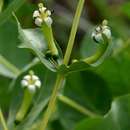en
names in breadcrumbs


Fadogia is a genus of flowering plants in the family Rubiaceae. The genera Rytigynia and Fadogia form a strongly supported clade but neither of these genera is monophyletic.[1]
Fadogia is found in Tropical Africa. F. cienkowskii and F. tetraquetra have the largest distribution and occur from Guinea to the Transvaal province. F. ancylantha and F. erythrophloea are also found in many African countries, but they don't occur so far south. The countries with the highest number of species are Angola, Democratic Republic of the Congo, Zambia, Tanzania, and Central African Republic.[2]
Endophytic bacteria are housed in the intercellular space of the leaf mesophyll tissue. The presence of these bacteria can only be microscopically ascertained. The bacteria are identified as Burkholderia, which is a genus that is also found in the leaves of other Rubiaceae species.[3][4] The hypothesis is that these endophytic bacteria provide chemical protection against insect herbivory.[5]
Fadogia homblei is known to cause gousiekte, a cardiotoxicosis of ruminants characterised by heart failure four to eight weeks after ingestion of certain rubiaceous plants.[6]
Fadogia is a genus of flowering plants in the family Rubiaceae. The genera Rytigynia and Fadogia form a strongly supported clade but neither of these genera is monophyletic.